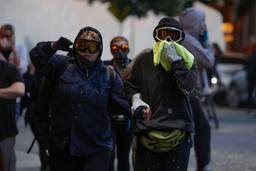U.S. Drug Shortage: Big Pharma, Big Phuck-Up
An under-regulated industry collapses in on itself; the sick pay the price.
Terry J. Allen

The wait is over: Even without socialist healthcare you can enjoy drug rationing. More than 200 drugs – from chemotherapy staples to antibiotics, from anesthesia to morphine – are now being denied to critically ill people, rationed or scalped at stratospheric prices. Quality problems, including potentially deadly microbial contamination, caused more than half the recent shortages in injectable drugs, according to the Food and Drug Administration.
”Pharmacists are scrambling and desperate,” says Amanda Forster of Premier Inc., a major hospital drug-purchasing cooperative. Five years ago the FDA reported only 55 drugs in short supply; by 2010, there were 178; and this year, Premier predicts, 350. The majority are low-profit generics, but big-name drugs are also affected. Hard-to-make sterile injectables such as anesthesias and chemotherapies are particularly hard hit.
Ondis Eardensohn discovered the problem firsthand on August 8, when the former rural Vermont postmaster and partner of the state archivist drove two hours to New Hampshire’s Dartmouth Hitchcock Hospital for an infusion of Doxil. The Johnson & Johnson (J&J) chemotherapy drug is one of the only remaining treatments for her stage-4 cancer. She went through the usual tests and was waiting for the infusion when her doctor walked in. “‘I’m sorry,’ he told me, ‘but we don’t have enough Doxil to treat you.’ “
“I drove home with no treatment. I was in shock,” said Eardensohn, 58, a warm and usually optimistic mother of two. “When you are at stage-4, your options get more and more limited. If you have one option taken away, it may have been your last.” A week later, the region’s major teaching hospital called her at home the night before her appointment to cancel another Doxil treatment.
Shortage fatalities
Dartmouth Hitchcock is not alone in being unable to supply some life-saving drugs, and in shopping for others on the gray market, where unofficial, unauthorized middleman-companies shill vital drugs like Times Square scalpers. In the first six months of 2011, some 99.5 percent of hospitals reported at least one drug shortage, according to a June American Hospital Association survey; 44 percent fell short on more than 20 drugs, and 78 percent rationed supply.
Shortages cost hospitals about $200 million a year. But there is a deeper price. The AHA survey revealed that shortages have caused “adverse patient outcomes” at 35 percent of facilities. The nonprofit Institute for Safe Medication Practices linked shortage-related drug substitutions to patient deaths.
In June, J&J had warned that no new patients could be started on Doxil, but that old patients like Eardensohn would be given priority for the life-extending drug through its warmly acronym-ized program: C.A.R.E.S. But on August 26, the hospital decided to switch her to a different drug. Eardensohn’s doctors had apparently lost faith in J&J’s ability to supply Doxil – even for the continuing patients for whom they C.A.R.E.[D].
“There are some [old users] that are qualified, but haven’t gotten Doxil,” admits J&J spokesperson Monica Neufang. How many? The length of the “waiting list” is “proprietary,” she says, and J&J “wouldn’t give that information to the FDA.”
The causes for the shortages are almost as varied as the drugs affected, but profit considerations are almost always a factor. In addition to contamination, cost-cutting manufacture, lack of raw ingredients, just-in-time production, Medicare price controls, pay-to-delay generic sweetheart deals, discontinuation of less lucrative products, outsourcing and substandard ingredients can impact supply and quality.
J&J insists that the Doxil shortage is “not due to concerns about product quality or safety.” The problem, says Neufang, is “production delays.”
In fact, it is not J&J that is doing the producing. Although Doxil bears the J&J brand, it is outsourced and produced by Ben Venue Laboratories, an Ohio-based third-party contract manufacturer. BVL press materials also vaguely blame “manufacturing capacity constraints.”
But Health Canada suggests an alternative. On August 17, Canada’s FDA counterpart banned importation of some BVL drugs for “quality deficiencies” and what Health Canada spokesperson Olivia Caron calls “shortcomings in the Good Manufacturing Practices … including product sterilization and quality oversight.”
Recognizing that desperate patients have nowhere to turn, Canada is allowing importation of Doxil and a few other “medically necessary drugs from BVL as the health benefits of these drugs outweigh the risk associated with the quality concerns.”
BVL spokesperson Jason Kutz said that concluding there was a link between the Canadian ban and quality issues was “inaccurate and misleading.”
Within days of the Canadian actions, and also facing restrictions on its products in Europe, BVL announced it was quitting contract-manufacturing. A division of Boehringer Ingelheim, based in Germany with affiliates in more than 100 countries, BVL also produces for Pfizer, Takeda and Bristol-Myers Squibb. BVL is part of a vast $46 billion global contract-manufacturing industry that plays a major role in the increasing globalization of the drug industry.
The global drug supply chain
Doxil is just one break in a world-wide supply chain corroded by Washington’s lax regulation and industry’s need to turn a profit.
Some industries more than others: In a move that makes Big Pharma look like Doctors Without Borders, gray-market price gougers are speculating, profiteering and cashing in, big time. Concentrating on the scarce, essential drugs that treat patients extremely ill with cancer and infections, or needing surgery, the gray marketers are extorting price hikes averaging 650 percent.
Which sounds almost humanitarian compared to the “astonishing markup of 6,213 percent” reported by the San Antonio Express-News. The faxed gray-market price for the lifesaving leukemia drug Cytarabine was among many offers deluging pharmacists.
“It’s shocking behavior,” says Premier’s Forster. “People are hoarding and profiteering on essential drugs to squeeze money out of hospitals.” Gray-market drugs raise safety concerns, she says, since before reaching a hospital pharmacy, they can pass through five or six brokers, getting repackaged, relabeled and possibly stored under poor conditions.
But quality and safety problems also affect drugs obtained through normal channels. “The largest percentage of current shortages is caused by domestic quality problems,” Mike Levy, acting director of Drug Security, Integrity and Recalls at FDA, told In These Times.
“[D]rugmakers in the U.S. are increasingly implementing cost-cutting measures that may directly or indirectly contribute to an increasing number of manufacturing quality issues,” Business Monitor International wrote. Last year Teva and Hospira – two of the United States’ largest makers of generics, including key chemotherapies – closed factories because of “manufacturing problems.” J&J units had to issue massive recalls, and the FDA placed three of its plants under consent decrees for persistent failures to meet quality standards.
Big Pharma’s rising reliance on cheaper imported ingredients and finished drugs is compounding the problem. “The race to the bottom has led to an increase of products coming from plants in China and India that may have uncertain supply and may have never been inspected,” Heather Bresch, president of the generic drug giant Mylan told The New York Times. A 2007 GAO report found that 586 U.S. drugs were made in China and 299 in India.
The availability and purity of foreign ingredients is a factor in the U.S. drug supply chain since – according to Huascar Batista, acting chief of the Import Operations Branch, Office of Compliance at FDA – “80 percent of all active pharmaceutical ingredients consumed in the U.S. are imported.”
While J&J and BVL deny quality problems with Doxil, both stonewall questions on foreign sourcing. “It’s proprietary,” Neyfang said. “Ask Ben Venue.” BLV’s Kurtz suggests asking J&J.
Meanwhile, the FDA, which is charged with ensuring safety, is hobbled by budget constraints, industry ties and the irrepressible demands of BigPharma’s deep-pocketed congressional lobbyists. “The growing challenges of globalization have far outstripped the nation’s product safety inspection and quality monitoring resources,” FDA Senior Regulatory Counsel Carolyn Becker told a $1,995-per-person pharmaceutical industry conference in early August.
It’s bad enough that the FDA inspects domestic facilities about once every 2.5 years, but it would take 9 years to inspect the prioritized list of companies in the 150 or so countries that export drugs or ingredients into America, the GAO reports. It certainly doesn’t help that the FDA lacks authority to mandate recalls, require prior notification of impending shortages and force companies to continue manufacturing essential drugs.
And even when problems are found with imports, the FDA can’t destroy poor quality or dangerous drugs. It can only refuse them entry, after which importers can “port shop” the rejected products: “They try at several different ports, and sometimes they are successful [in getting them into the U.S.],” says the FDA’s Batista.
That there is plenty of blame to go around is no help to Eardensohn. She wonders why gray marketers were able to hoard essential drugs when hospitals and government agencies did not adequately anticipate or prepare for shortages: “A lot of companies are making money hand over fist and not caring, not putting resources into old drugs with proven track records, and instead into ones that might be more profitable.” Indeed, while Doxil is a mainstay chemotherapy agent, it earns J&J less than 1 percent of its revenue.
“This thing horrifies me, and not just for me,” says Eardensohn, who has developed a cough during the extra month she waits without treatment. “This is a kind of healthcare rationing. Why hasn’t something been done?”









